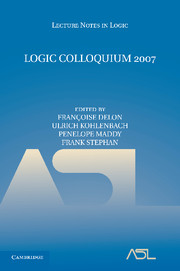Refine search
Actions for selected content:
5849 results in Programming Languages and Applied Logic
Contents
-
- Book:
- Finite and Algorithmic Model Theory
- Published online:
- 01 June 2011
- Print publication:
- 10 March 2011, pp v-vi
-
- Chapter
- Export citation
4 - Definability in classes of finite structures
-
-
- Book:
- Finite and Algorithmic Model Theory
- Published online:
- 01 June 2011
- Print publication:
- 10 March 2011, pp 140-176
-
- Chapter
- Export citation
2 - Logical aspects of spatial databases
-
-
- Book:
- Finite and Algorithmic Model Theory
- Published online:
- 01 June 2011
- Print publication:
- 10 March 2011, pp 77-108
-
- Chapter
- Export citation
Frontmatter
-
- Book:
- Finite and Algorithmic Model Theory
- Published online:
- 01 June 2011
- Print publication:
- 10 March 2011, pp i-iv
-
- Chapter
- Export citation
Preface
-
-
- Book:
- Finite and Algorithmic Model Theory
- Published online:
- 01 June 2011
- Print publication:
- 10 March 2011, pp vii-xii
-
- Chapter
- Export citation
5 - Algorithmic meta-theorems
-
-
- Book:
- Finite and Algorithmic Model Theory
- Published online:
- 01 June 2011
- Print publication:
- 10 March 2011, pp 177-270
-
- Chapter
- Export citation
1 - Automata-based presentations of infinite structures
-
-
- Book:
- Finite and Algorithmic Model Theory
- Published online:
- 01 June 2011
- Print publication:
- 10 March 2011, pp 1-76
-
- Chapter
- Export citation
3 - Some connections between finite and infinite model theory
-
-
- Book:
- Finite and Algorithmic Model Theory
- Published online:
- 01 June 2011
- Print publication:
- 10 March 2011, pp 109-139
-
- Chapter
- Export citation
Bibliography
-
- Book:
- Finite and Algorithmic Model Theory
- Published online:
- 01 June 2011
- Print publication:
- 10 March 2011, pp 339-341
-
- Chapter
- Export citation
6 - Model theoretic methods for fragments of FO and special classes of (finite) structures
-
-
- Book:
- Finite and Algorithmic Model Theory
- Published online:
- 01 June 2011
- Print publication:
- 10 March 2011, pp 271-338
-
- Chapter
- Export citation

Logic Colloquium 2007
-
- Published online:
- 01 March 2011
- Print publication:
- 07 June 2010
8 - Beyond Nash Equilibrium: Solution Concepts for the 21st Century
-
-
- Book:
- Lectures in Game Theory for Computer Scientists
- Published online:
- 01 June 2011
- Print publication:
- 06 January 2011, pp 264-290
-
- Chapter
- Export citation
Contents
-
- Book:
- Lectures in Game Theory for Computer Scientists
- Published online:
- 01 June 2011
- Print publication:
- 06 January 2011, pp v-vii
-
- Chapter
- Export citation
2 - Infinite Games and Automata Theory
-
-
- Book:
- Lectures in Game Theory for Computer Scientists
- Published online:
- 01 June 2011
- Print publication:
- 06 January 2011, pp 38-73
-
- Chapter
- Export citation
List of contributors
-
- Book:
- Lectures in Game Theory for Computer Scientists
- Published online:
- 01 June 2011
- Print publication:
- 06 January 2011, pp viii-viii
-
- Chapter
- Export citation
6 - Games with Imperfect Information: Theory and Algorithms
-
-
- Book:
- Lectures in Game Theory for Computer Scientists
- Published online:
- 01 June 2011
- Print publication:
- 06 January 2011, pp 185-212
-
- Chapter
- Export citation
4 - Back and Forth Between Logic and Games
-
-
- Book:
- Lectures in Game Theory for Computer Scientists
- Published online:
- 01 June 2011
- Print publication:
- 06 January 2011, pp 99-145
-
- Chapter
- Export citation
3 - Algorithms for Solving Parity Games
-
-
- Book:
- Lectures in Game Theory for Computer Scientists
- Published online:
- 01 June 2011
- Print publication:
- 06 January 2011, pp 74-98
-
- Chapter
- Export citation
Frontmatter
-
- Book:
- Lectures in Game Theory for Computer Scientists
- Published online:
- 01 June 2011
- Print publication:
- 06 January 2011, pp i-iv
-
- Chapter
- Export citation
1 - A Primer on Strategic Games
-
-
- Book:
- Lectures in Game Theory for Computer Scientists
- Published online:
- 01 June 2011
- Print publication:
- 06 January 2011, pp 1-37
-
- Chapter
- Export citation
